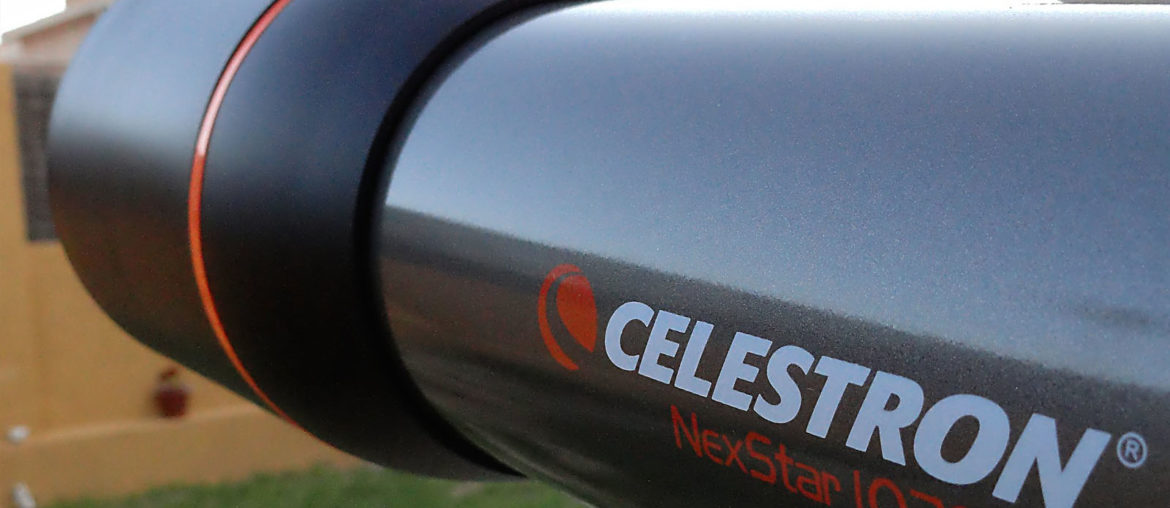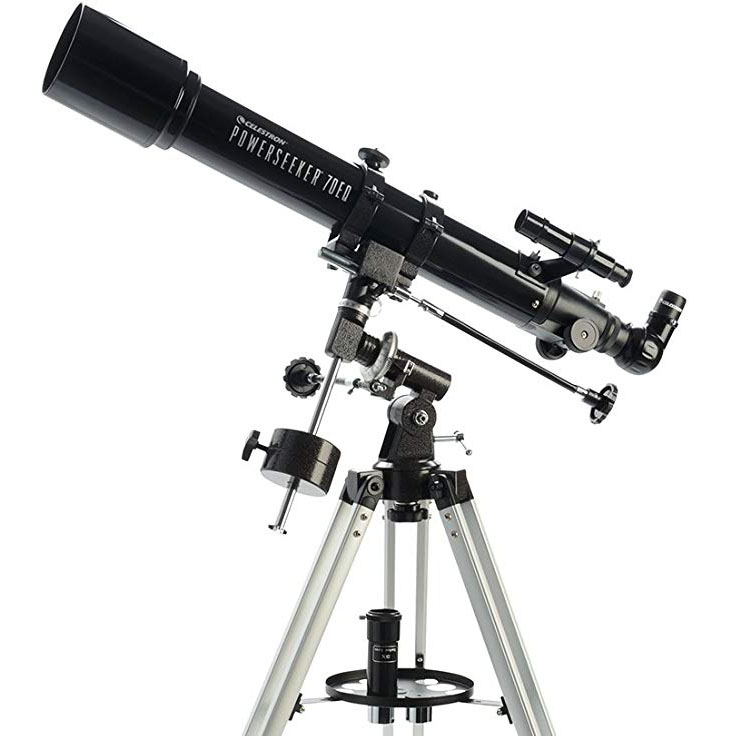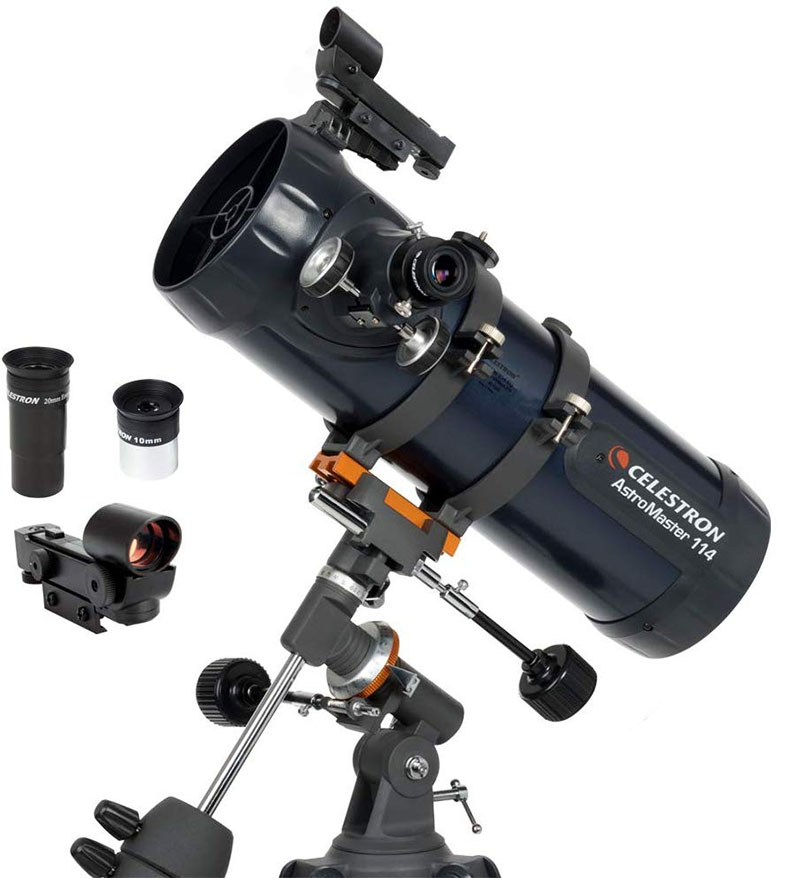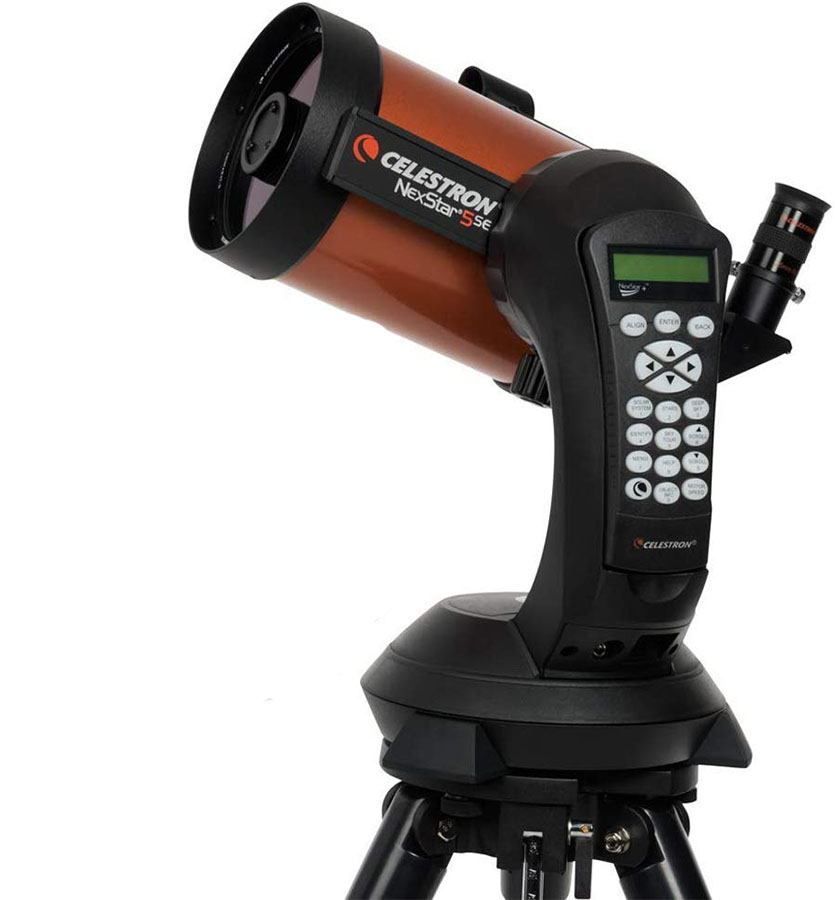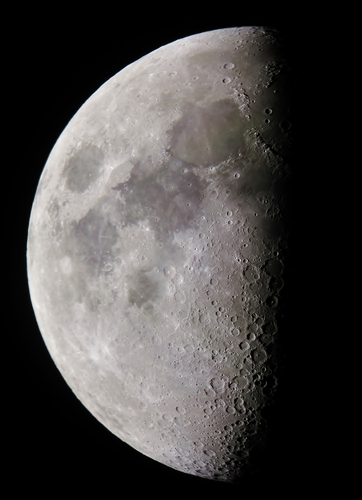When it comes to shopping for a new telescope a few brands will quickly pop up as the most recognized ones: Orion, Meade Instruments and Celestron. But is this fame well deserved? Are Celestron telescopes high quality? In this
We’ll review three different telescopes, one in every price point so you have an option that fits your needs.
Our picks and reviews
- Best budget/entry-level telescope: Celestron PowerSeeker 70EQ
- Best midrange telescope: Celestron AstroMaster 114EQ
- Best high range telescope: Celestron Nexstar
Celestron AstroMaster vs Celestron PowerSeeker
When you start researching Celestron telescopes you will find something that seems a bit strange. You will find multiple telescopes in the same price-range and with similar technical specifications. This seems counterintuitive as tech brands usually don’t like to have many products with similar prices so they don’t cannibalize each other’s sales and so customers don’t get confused so there must be a good reason for this, right?.
Well, not really. Both the AstroMaster and the PowerSeeker sub brands don’t really follow any distinguishable pattern in terms of quality or build. Both go into varios price ranges and types of telescopes so don’t worry too much about it and focus on the other telescope specs.
What do the model names mean?
Besides the brand name on Celestron products, you will find a model name that looks something like 80AZ or 114EQ. These models names have a meaning that will let you know some of the tech specs.
The first number like 80 or 144 in our previous examples refers to the telescope’s aperture. The aperture is in simple terms the diameter of the lens or mirror that captures the light. A simple rule for aperture is the bigger the better but if you want to get into the details of it, we have an article explaining telescope aperture.
The second part of the model (AZ or EQ) refers to they type of mount the model uses. AZ is short for Alt-Azimuth. This is the most basic type of mount. These telescopes turn on its base and angle upwards. Controlling them is really simple and they are sometimes recommended for beginners, but some people complain it is a bit hard to track moving objects with it.
EQ is for equatorial mounts. These types of mounts have a bit of a learning curve and you will need some practice to use them correctly as they are a bit more complex, but they offer slow motion controls to help you keep better track of moving objects. Some people believe equatorial mounts are the only option if you really want to get into stargazing.
Celestron PowerSeeker 70EQ Review
Tech specs
| Telescope type | Refractor |
| Aperture | 2.76″ (70mm) |
| Magnification | 35x, 175x |
| Weight | 13.9 lbs (6.3 Kg) |
| Included eyepieces | 4mm, 20mm, 3x Barlow lens |
| Limiting Magnitude | 11.7 |
| Maximum useful magnification | 165x |
| Mount type | German |
Entry level telescopes should have two characteristics for them to be a worthy purchase: High quality optics and and learning curve.
High quality optics seems obvious, and yet there are many brands that cheapen out and pack poorly manufactured lenses and cheap eyepieces in order to cut costs and keep their retail prices below a certain mark. This is not a problem with the PowerSeeker 70EQ. While the specs of the telescope are quite modest, the build quality and optic instruments are just as good as their higher end versions. It is definitely a product that is made to introduce people to the astronomy hobby and get them to enjoy it.
As for the learning curve, there are telescopes that seek to gift you an amazing first-time experience. You take them out of the box, set them up in two minutes and bam! you are looking at the Moon’s craters in all their splendor.
While that’s great, the problems start the fourth or fifth time you use it when you realize you want to move on to watch other objects (often moving ones) and you notice your telescope doesn’t give you much flexibility in terms of usage. The mount is clunky, the eyepieces are too basic, etc. Then you get
This is why it is important for even an
In this regard, the PowerSeeker 70EQ comes with an equatorial mount, which seems a bit complex at first, but you will be thankful for having selected it instead of an azimuth mount which is simpler to set up but very limited in functionality.
The included eyepieces will also give you a good range in the type of objects you can observe, with the 4mm one even being overkill for the max magnification the telescope supports.
While there is a smaller telescope of in the PowerSeeker line with a lower price point, we believe an aperture of 70mm is the minimum necessary to have a good stargazing experience. Anything less than that really isn’t worth it.
The recommended audience for the 70EQ are the following:
- First telescope for a kid
- First telescope for a teenager
- First telescope for an adult on a tight budget
Upgrade path:
A good telescope will have ways to maximize its useful life span and capabilities with some upgrades once you have mastered the included one. For the PowerSeeker 70EQ we’d recommend the following to really get the most out of it:
Change the eyepieces for Plossl (1.25″size is standard, if you find a deal with another brand, go for it, just make sure it says “Plossl”):
Get a smartphone or camera adapter so you can take photos:
Summary
| Pros | Cons |
| * Very accessible price * Good optics for the aperture range * Should last you for a long time | * Limited aperture * A bit heavy. Kids will probably need supervision to set it up * No smartphone adapter included |
Check out the PowerSeeker 70EQ on Amazon
Celestron AstroMaster 114EQ Review
| Telescope type | Newtonian |
| Aperture | 4.48″ (114mm) |
| Magnification | 50x, 100x |
| Weight | 17 lbs (7.7 Kg) |
| Included eyepieces | 10mm, 20mm |
| Limiting Magnitude | 12.8 |
| Maximum useful magnification | 269x |
| Mount type | German |
For our next pick we are going with the first reflector telescope in our list.
Reflector telescopes (or Newtonian as they are sometimes referred as ) use a set of mirrors instead of lenses to capture light and send it through the telescope’s body. They solve a common optical problem with refractor telescopes called chromatic aberration that without getting into too many technical details results generally in a worse image.
The downside of
One thing you need to learn about when purchasing a reflector telescope is collimation. Collimation basically means adjusting the mirrors inside to make sure you are getting a perfect image. This needs to be done every few months or yearly depending on how much you move around and use your telescope. At first, collimation seems a bit intimidating as you really don’t want to damage the expensive mirrors, some people even hire someone else to do it for them and while that is an option, we recommend that you learn to do it yourself because it’s really not as scary as it seems. We wouldn’t recommend letting a kid do it by themselves though, they will need some supervision.
The AstroMaster 114EQ also adds a big upgrade in comparison to cheaper models, a Star Pointer FinderScope. The FinderScope is a lens that goes at the top of your telescope that projects a red LED into the object you want to observe so it’s easier to find. Think of it
One thing we haven’t mentioned yet is that all Celestron telescopes come with a free copy of the Starry Night app. A downloadable app for your phone or laptop that serves as a real-time star chart, letting you know what objects and constellations are in the sky at the moment in your location and where to look for them. While it’s not the best star chart on the market, hey it’s free and it gets the job done.
The one “but” that we can find for the AstroMaster 114EQ are the included eyepieces. It comes with one 10mm and one 20mm Kellner eyepieces. While they are good enough, they don’t bring out the best images this telescope is capable of. If you really want to maximize your viewing experience it is recommended that you switch to Plossl eyepieces (the difference between the two of them is Plossl use two lenses instead of just one and therefore are more expensive). It is understandable that they have to add the basic eyepieces to keep the price down but it doesn’t help the out-of-the-box experience to know that you are eventually going to need to get additional accessories.
If you want to go for a bigger aperture, there’s a 130mm model of this that is basically the same but a bit larger. We believe that extra money would be better off being invested into a better eyepiece but if you have some budget to work with, go for it, the extra aperture is always nice.
We also recommend that you grab the optional smartphone adapter so you can take photos of the sky.
We recommend the AstroMaster 114EQ in the following situations:
- A beginner astronomer with a bit of a budget to work with
- First telescope for a teenager
- Secondary portable telescope if you own a big, heavy, sophisticated one.
Upgrade path
For possible upgrades that will help you get the most out of your telescope, we recommend the following
- Gosky eyepiece, lens and filter kit for those Plossl eyepieces we mentioned above
- Gosky deluxe telescope Nikon camera adapter – If you have a DSLR you will be taking some amazing photos with this. Here’s the Canon version.
Summary
| Pros | Cons |
| * Very * Powerful, high aperture * Includes everything you need to get deep into astronomy | * Includes basic eyepieces only * Collimation required ( |
Check out the AstroMaster 114 EQ on Amazon
Celestron Nexstar Review
Note: We are using the specs for the 5″model which is the one we are recommending. The Nexstar has 4″, 5″, 6″and 8″models so their respective specs might change a little bit.
| Telescope type | Schmidt-Cassegrain |
| Aperture | 5″ (127mm) |
| Magnification | 50x |
| Weight | 27.6 lbs (12.5 Kg) |
| Included eyepieces | 10mm, 20mm |
| Limiting Magnitude | 13 |
| Maximum useful magnification | 295x |
| Mount type | Motorized single fork arm |
Now let’s say you have absolutely no question you want to get deep into stargazing and you want a powerful telescope to work with. Or maybe you have tried an entry-level on and you are ready to move on to the next level. Enter the Celestron Nexstar.
The Nexstar is probably the most recognizable of the Celestron lines thanks to its iconic orange tube design they have kept for quite some time. It is a bit like a MacBook, you just know what company made it the second you look at it.
Speaking of computers, now we are entering the range of computarized telescopes. In the case of Celestron, they use their propietary SkyAlign software that allows you to select objects from a database and the telescope automatically aligns itself to track the object(s) you want. It also allows you to create “tours” so you can keep track of moving objects.
The Nexstar uses a Schmidt-Cassegrain design which is more advanced than simple refractor or Newtonian telescopes. Schmidt-Cassegrains solve a lot of optic issues Newtonian telescopes tend to have like
With the kind of
If astrophotography is one of your objectives with the telescope and you have the budget for it, we do recommend spending a bit more and going for the 8″ model. It will capture about 78% more light than the 5″ which makes a significant difference when taking high exposure photos. If you only plan to use it for observing then save some money and stick with the 5″ or 6″.
In terms of accessories, the Nexstar only comes with a single 25mm eyepiece, buit as you would expect from a telescope in this price range, it is a high quality plossl lens.
The built-in eyepiece is great for general use, but you will definitely want to invest in some additional eyepieces for specific use cases like deep sky watching. A 32mm
There is no shortage of accessories for the Nexstar series. The computerized pad and motor work on AA batteries which can last you a few hours. If you plan to go longer than that you can get an AC adapter or a power tank. You can also get a really cool wi-fi adapter that allows you to align and control the motor using your smartphone or laptop, but the really interesting thing is that it can connect the telescope with Celestron’s starry night app that lets you create an automatic tour of the most important features in the night sky depending on the time and location you are in.
In conclusion, you can’t really go wrong with the Nexstar series. It is one of the most complete offerings in telescopes for enthusiasts and hobbyist astronomers.
| Pros | Cons |
| * Powerful optics * Reasonable portability * Wide range of accessories | * Short battery life, AC adapter sold separately * Includes only one eyepiece |

